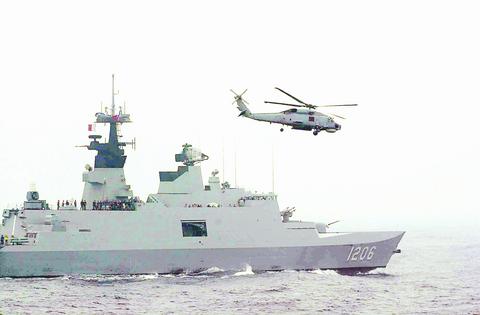The navy held a live-fire exercise off the coast of Kaohsiung yesterday at a location close to where one of the Chinese ballistic missiles landed in 1996, a provocation which sparked the 1996 Taiwan Strait Crisis.
The drill, organized specifically for the press, was conducted by the Ministry of National Defense (MND) and featured two Lafayette-class frigates, which the ROC Navy purchased from France.
It originally was to include a bombardment of mock surface targets by two sorties of F-16 fighter planes, but the maneuver was cancelled at the last moment because of bad weather.

PHOTO: CHIANG YING-YING, TAIPEI TIMES
One remaining part of the exercise -- firing of live ammunition from the Lafayette-class frigate Tihua's 76mm gun -- went ahead as planned.
The live-fire drill took place about 55km west of Kaohsiung's Tsoying naval harbor, close to one of the locations where China's ballistic missiles landed in 1996.
Most of the top brass charged with defending southern Taiwan were present for the occasion.
The MND said that it organized the exercise to demonstrate military readiness before the Lunar New Year. Similar campaigns are held every year at this time and they are meant to assure Taiwanese that the country is safe from harm.
The navy bought a total of six Lafayette-class frigates from France in the last decade. The frigates are the most advanced warship in the ROC Navy, which also includes Chengkung-class and Knox-class frigates.
The Lafayettes travel at a relatively fast speed and feature a streamlined design and state-of-the-art equipment, but they have a relatively weak arsenal.
The ship's weakest point is its air-defense weaponry, which is comprised mostly of short-range missiles.
The navy is seeking to upgrade the air-defense capability of its Lafayettes, with Chung Shan Institute of Science and Technology (CSIST) eagerly bidding for the deal.
CSIST has developed a vertical launch system (VLS) for air defense missiles that makes use of a sea-to-air version of the Tien Chien-II anti-aircraft missile, sources said.
A CSIST proposal is asking the navy to allow the institute to use one of the six Lafayette-class frigates as the test-platform for the VLS, but the navy has been hesitant to let the costly frigates be used to test a system that hasn't proven its effectiveness.
The navy's hesitation is a likely indication that it is ready to refuse the air defense package and some military buffs are saying that it may instead adapt the US-made Standard SM-II air defense missile to the VLS, not the Tien Chien-II missiles.
The Standard SM-II system generated some controversy in October when PFP Lawmaker and ex-navy chief Nelson Ku (顧崇廉) criticized plans to buy the missile at three times its market value.

SHIPS, TRAINS AND AUTOMOBILES: The ministry has announced changes to varied transportation industries taking effect soon, with a number of effects for passengers Beginning next month, the post office is canceling signature upon delivery and written inquiry services for international registered small packets in accordance with the new policy of the Universal Postal Union, the Ministry of Transportation and Communications said yesterday. The new policy does not apply to packets that are to be delivered to China, the ministry said. Senders of international registered small packets would receive a NT$10 rebate on postage if the packets are sent from Jan. 1 to March 31, it added. The ministry said that three other policies are also scheduled to take effect next month. International cruise ship operators

HORROR STORIES: One victim recounted not realizing they had been stabbed and seeing people bleeding, while another recalled breaking down in tears after fleeing A man on Friday died after he tried to fight the knife-wielding suspect who went on a stabbing spree near two of Taipei’s busiest metro stations, Taipei Mayor Chiang Wan-an (蔣萬安) said. The 57-year-old man, identified by his family name, Yu (余), encountered the suspect at Exit M7 of Taipei Main Station and immediately tried to stop him, but was fatally wounded and later died, Chiang said, calling the incident “heartbreaking.” Yu’s family would receive at least NT$5 million (US$158,584) in compensation through the Taipei Rapid Transit Corp’s (TRTC) insurance coverage, he said after convening an emergency security response meeting yesterday morning. National

PLANNED: The suspect visited the crime scene before the killings, seeking information on how to access the roof, and had extensively researched a 2014 stabbing incident The suspect in a stabbing attack that killed three people and injured 11 in Taipei on Friday had planned the assault and set fires at other locations earlier in the day, law enforcement officials said yesterday. National Police Agency (NPA) Director-General Chang Jung-hsin (張榮興) said the suspect, a 27-year-old man named Chang Wen (張文), began the attacks at 3:40pm, first setting off smoke bombs on a road, damaging cars and motorbikes. Earlier, Chang Wen set fire to a rental room where he was staying on Gongyuan Road in Zhongzheng District (中正), Chang Jung-hsin said. The suspect later threw smoke grenades near two exits

The Forestry and Nature Conservation Agency yesterday launched a gift box to market honey “certified by a Formosan black bear” in appreciation of a beekeeper’s amicable interaction with a honey-thieving bear. Beekeeper Chih Ming-chen (池明鎮) in January inspected his bee farm in Hualien County’s Jhuosi Township (卓溪) and found that more than 20 beehives had been destroyed and many hives were eaten, with bear droppings and paw prints near the destroyed hives, the agency said. Chih returned to the farm to move the remaining beehives away that evening when he encountered a Formosan black bear only 20m away, the agency said. The bear